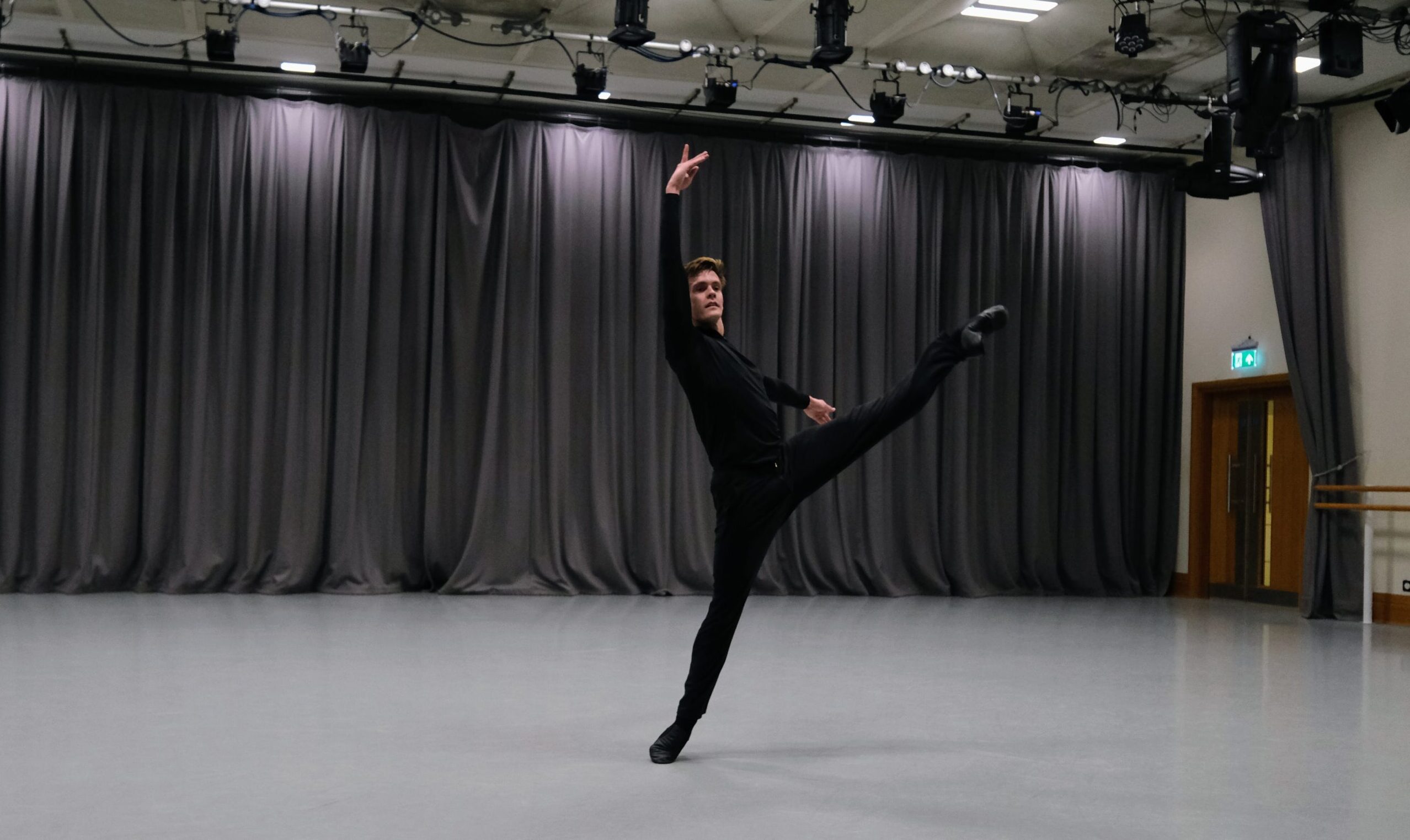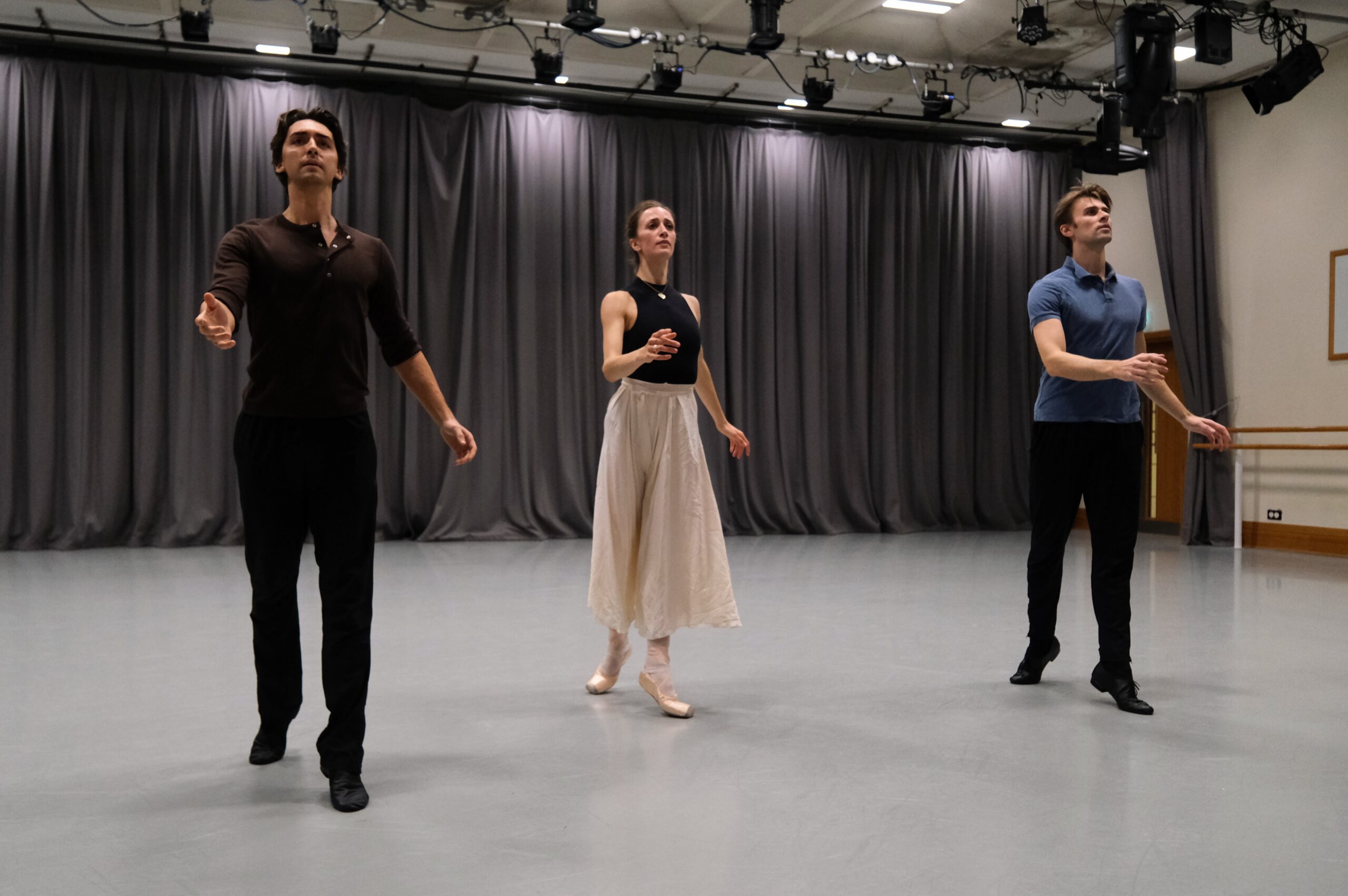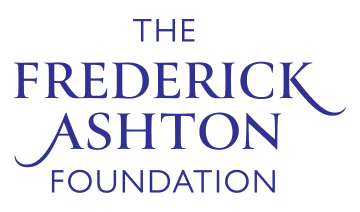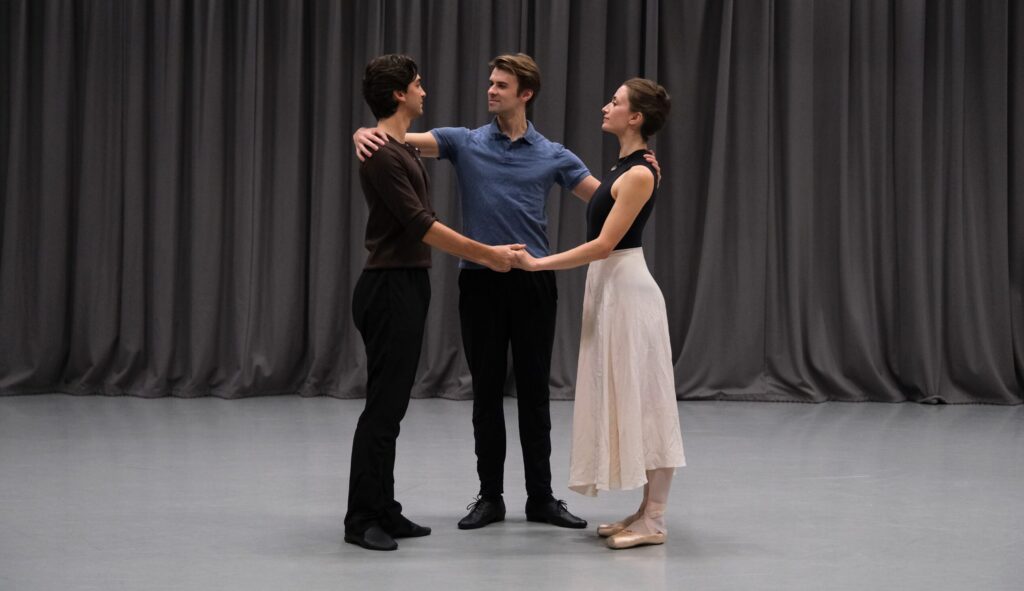Téo Dubreuil, Aiden O’Brien and Annette Buvoli in the ‘Nimrod’ variation from Ashton’s Enigma Variations during an Ashton Rediscovered masterclass, October 2025 ©The Frederick Ashton Foundation. Ph Rachel Thomas.
by Jane Pritchard, taken from her introduction to the Ashton Rediscovered masterclass on 19 October 2025
Enigma Variations is a ballet of mood set around a biographical event rather than an actual biography. It is a ballet about friendship and the loneliness of the creative artist. Created by Frederick Ashton to Elgar’s now famous score Enigma Variations, with designs by Julia Trevelyan Oman, it was first performed on stage at the Royal Opera House on 25 October 1968.
Elgar’s opus 36, originally called Variations on an original theme, was composed between October 1898 and February 1899, and received its premiere at St James’s Hall, London, on 19 June 1899. Ashton’s ballet uses the shorter version of the final movement of Enigma Variations, which John Lanchbery copied from manuscript in British Library.
While still a very young choreographer, Ashton wrote in the Dancing Times in May 1930:
Anyone contemplating the arrangement of a ballet should first become so well acquainted and imbued with the spirit of whatever period he chooses to portray as to allow the style to flow naturally and unselfconsciously through his work, inspired by the music and avoiding always exaggeration of style which leads to mannered as opposed to truthful conception.
This seems to have been an idea that guided Ashton’s creative career—and the spirit of the late Victorian period and inspiration taken from the score were central to Enigma.
In a programme note for the original production, John Lanchbery claimed that ‘Elgar said towards the end of his life that if the Variations had been written by a Russian composer they would have been produced as a ballet long ago. He visualised the setting as a banqueting-hall with a veiled dancer as the Enigma.’ In Britain, Frank Staff had choreographed to Elgar’s score in 1940 in a short-lived version without narrative.
Ashton provided a programme note for his ballet, explaining that the action took place in Worcestershire at the time the Variations were composed:
Some time before the action of the ballet takes place, Elgar has sent the score of Enigma Variations to the famous conductor Richter in the hope of interesting him in the work. The characters, intimates and friends of the composer, dance their variations, at the end of which a telegram arrives from Richter, addressed to their mutual friend Jaeger, agreeing to conduct the first performance.
The production’s birth owes itself to its designer Julia Trevelyan Oman. Early in the 1950s, when she was studying theatre design at the Royal College of Art, she had the idea for a ballet based on Elgar’s score. Her tutor, Hugh Casson, was so impressed with her work that he contacted Ninette de Valois, who suggested that Oman left her portfolio of designs at the stage door of the Royal Operas House. De Valois was creating few new works in the 1950s and Oman, hearing nothing after six months, requested the return of her portfolio.
Ashton had taken a look at the portfolio, but he did not feel the time was right for such a ballet, and was uncertain about the music. Clearly it remained at the back of his mind, though, and he recollected Oman’s covering note written in brown ink on green paper. In the interim, Oman had become a successful, meticulous designer among whose works were the designs for Jonathan Miller’s 1966 television version of Alice in Wonderland, in which the characters were played as Victorians rather than following Tenniel’s illustrations.
Ashton phoned Oman. Was she the person who had left her designs at Covent Garden all those years ago? Was she still interested? She was, but her style had changed and she would want to redesign it.
Oman went to Worcestershire to undertake research: visiting the Elgar Museum, learning all she could about ‘the friends pictured within’ the music and seeking out photographs of them. She set the ballet in a late-Victorian country house and ‘wanted to bring the garden and surrounding feeling of Worcestershire onto the stage’.
The set is therefore garden on left as the audience views the stage, complete with a stone gateway arch more or less centre back, while on the right is the brown wood panelling of a hall, complete with practical staircase. In the garden is a hammock, in the house tables and chairs. In some respects, it appears more like a set for a play than a ballet, but plenty of space has been left for dancing. The impression given is that this is Elgar’s home, although it is somewhat grander that Craeg Lea, his home near Malvern from 1899–1904, or his country cottage, Birchwood Lodge, at Great Storridge (1898–1903). Significantly, the interior-exterior nature of the set serves as a useful background to the range of individual characters presented and, as Ashton’s biographer David Vaughan noted, ‘It seems possible that Ashton at least conceived the action as being simultaneously interior and exterior… that it takes place in the memory of the protagonist rather than in actuality’.
The dancers are dressed and made up to resemble the characters they represent—wearing Victorian clothes, with outfits only slightly modified for dance. The headline for AV Coton’s review in The Daily Telegraph was ‘Victorian realism of Elgar Ballet’, while critic Richard Buckle included the misleading comment, ‘The costumes are realistic, so dancing is not what we are going to see.’
For Ashton, the time was right to create Enigma. He was coming to the end of his tenure as Artistic Director of The Royal Ballet, scheduled for 1970, and had learnt that the Royal Opera House had no intention of renewing his contract. The theme of loneliness and the rejection of an artist must have resonated with him. His previous creation had been Jazz Calendar, and there could be no greater contrast than that between them.
The late 1960s were also a time when the Victorian period was being re-evaluated and appreciated after a long time of dismissal. It is surely not just chance that Antony Tudor’s ‘Edwardian’ Lilac Garden was staged at Covent Garden, opening a month after Enigma. In addition, that year – 1968 – saw the first Laura Ashley dress shop open under the Laura Ashley name in South Kensington.
Structurally, parallels may be found in Ashton’s 1937 A Wedding Bouquet, with its vignettes of characters at a wedding, and Tudor told Vaughan that Enigma reminded him of The Lord of Burleigh, created for Camargo Society in 1931—in which Ashton brought together characters from Tennyson’s poems in series of divertissements.
Enigma Variations has a cast of 24 including the 14 ‘friends pictured within’, and a programme note by Elgar stated, ‘The sketches are not “portraits” but each variation contains a distinct idea founded on some particular personality or perhaps on some incident known only to two people.’
At the Ashton Rediscovered masterclass on Sunday 19 October, two characters and their variations were presented—those for Arthur Troyte Griffith (Troyte), ‘A very close friend, outspoken and brusque though the boisterous mood is mere banter,’ and for AJ Jaeger: ‘This variation recalls a summer evening’s talk about Beethoven and further reveals the depth of a friendship.’

Harrison Lee dancing the ‘Troyte’ variation from Ashton’s Enigma Variations during an Ashton Rediscovered masterclass, October 2025 ©The Frederick Ashton Foundation. Ph Rachel Thomas.
Troyte was created by Anthony Dowell and, after the first performance, critic John Percival wrote, ‘It’s a fantastic dance and I cannot imagine anyone else being able to do it.’ The inspiration was a Malvern architect nicknamed ‘the giddy Ninepin’, and his music, with its tempestuous mood, leads to a solo of explosive leaps, changes of directions and chaîné turns that continue to challenge dancers. Troyte was a close friend of Elgar who tried to teach him to play the piano, and the music ‘good-naturedly mimics his enthusiastic incompetence’—opening with Troyte bursting in and lifting the imagined piano lid and ending with his hands slamming the piano in frustration.

Téo Dubreuil, Aiden O’Brien and Annette Buvoli in the ‘Nimrod’ variation from Ashton’s Enigma Variations during an Ashton Rediscovered masterclass, October 2025 ©The Frederick Ashton Foundation. Ph Rachel Thomas.
In total contrast, the ninth variation was created for Elgar’s German-born friend August Johannes Jaeger, who had become the head of music publishing at Novello. The title, ‘Nimrod’, was an allusion to a hunter in Genesis, and a pun on the German word for hunter. (Jaeger’s family changed their surname to Hunter owing to anti-German sentiments in the First World War.) The idea behind the dance is that Elgar was depressed and about to give up composing when Jaegar visited and encouraged him to continue—to be like Beethoven, who had a lot of worries but continued to write more beautiful music. Critic Noel Goodwin described the dance:
Ashton has handled the ‘Nimrod’ variation itself with superb and moving restraint… By keeping movement at first to a minimum he allows the music to express all it has to communicate to each individual pair of ears, and only then does he begin to counterpoint it with a soberly danced conversation between Jaeger and Elgar. As the music becomes richer and still more eloquent, Elgar’s wife adds her support to Jaeger’s.
Elgar’s daughter, Carice, saw Ashton’s Enigma Variations at its first matinee performance. She wrote/said to Ashton:
The more I think of it, the more I am amazed and delighted with your conception of the Variations—not a nuance of the character has escaped you. It was an unforgettable experience, and I am so thankful that you were the person to make it. Thank you more than I can say.
Watch the Enigma Variations Ashton Rediscovered: masterclass on YouTube
Jane Pritchard MBE is Curator of Dance for the Victoria and Albert Museum, London, and one of the most distinguished British historians of dance. She has held positions as archivist of Rambert Dance Company and English National Ballet, and has written widely on the Ballets Russes and on 19th- and 20th-century dance.

